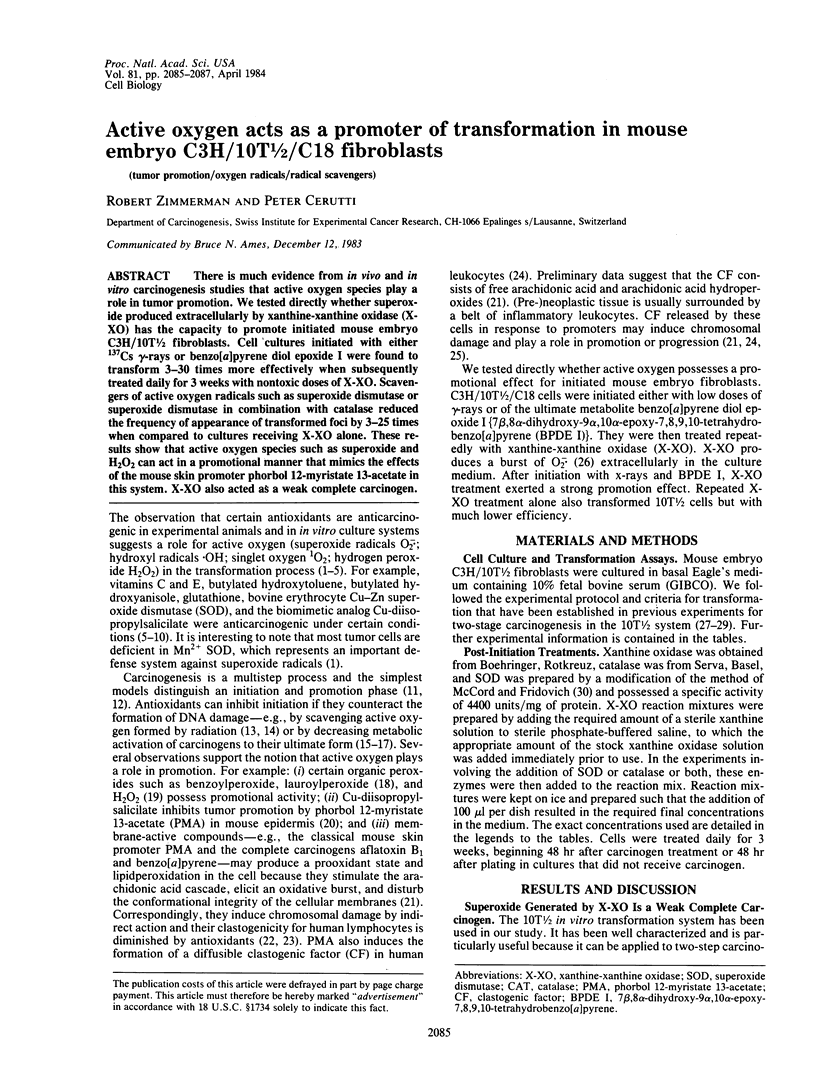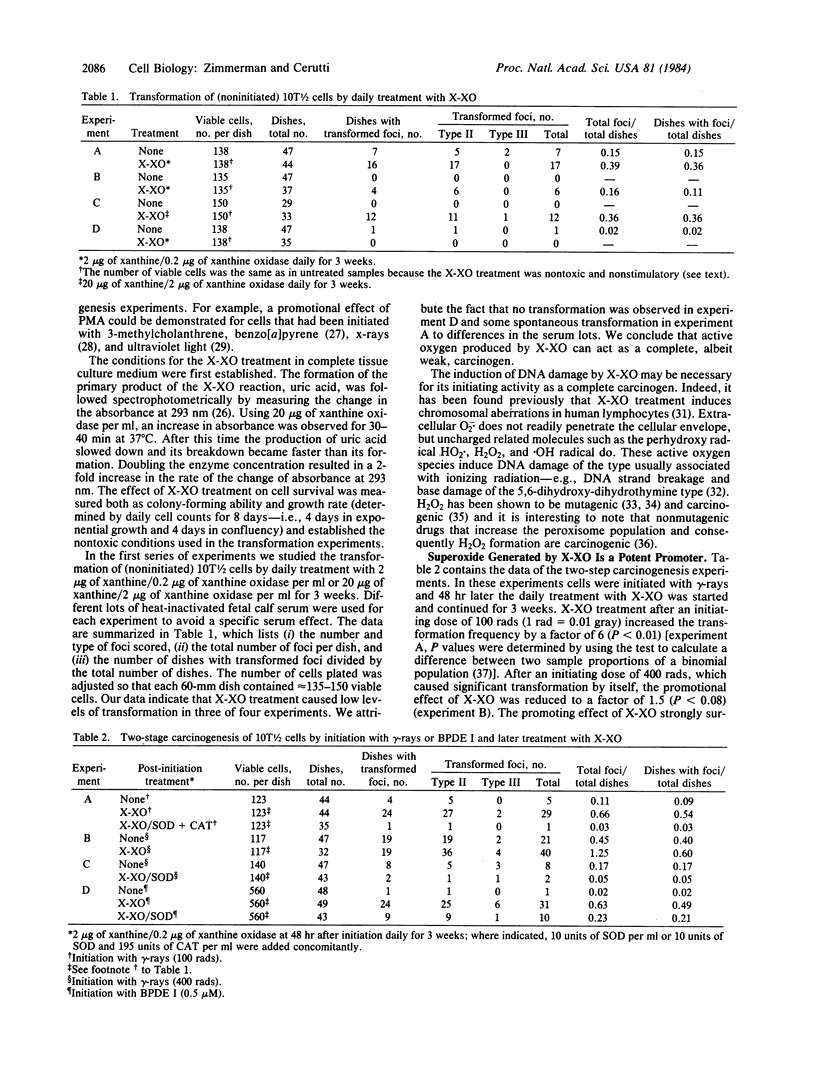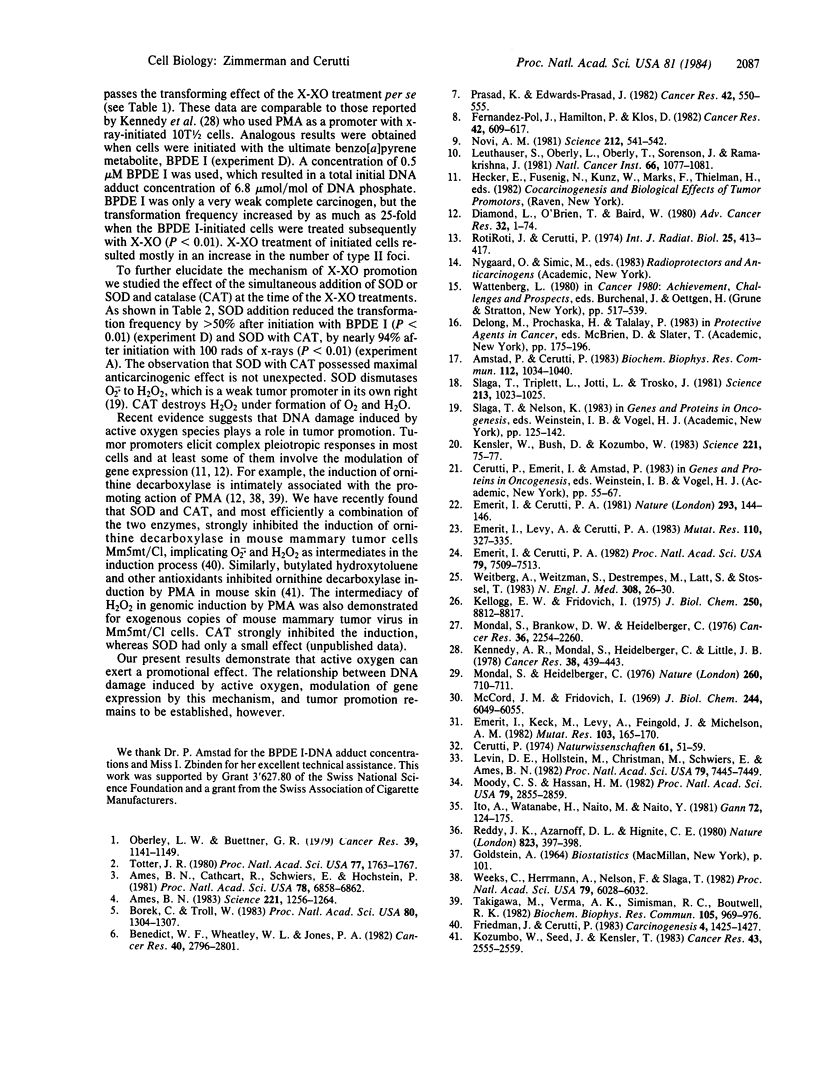Abstract
There is much evidence from in vivo and in vitro carcinogenesis studies that active oxygen species play a role in tumor promotion. We tested directly whether superoxide produced extracellularly by xanthine-xanthine oxidase (X-XO) has the capacity to promote initiated mouse embryo C3H/10T1/2 fibroblasts. Cell cultures initiated with either 137Cs gamma-rays or benzo[a]pyrene diol epoxide I were found to transform 3-30 times more effectively when subsequently treated daily for 3 weeks with nontoxic doses of X-XO. Scavengers of active oxygen radicals such as superoxide dismutase or superoxide dismutase in combination with catalase reduced the frequency of appearance of transformed foci by 3-25 times when compared to cultures receiving X-XO alone. These results show that active oxygen species such as superoxide and H2O2 can act in a promotional manner that mimics the effects of the mouse skin promoter phorbol 12-myristate 13-acetate in this system. X-XO also acted as a weak complete carcinogen.
Full text
PDF


Selected References
These references are in PubMed. This may not be the complete list of references from this article.
- Ames B. N., Cathcart R., Schwiers E., Hochstein P. Uric acid provides an antioxidant defense in humans against oxidant- and radical-caused aging and cancer: a hypothesis. Proc Natl Acad Sci U S A. 1981 Nov;78(11):6858–6862. doi: 10.1073/pnas.78.11.6858. [DOI] [PMC free article] [PubMed] [Google Scholar]
- Ames B. N. Dietary carcinogens and anticarcinogens. Oxygen radicals and degenerative diseases. Science. 1983 Sep 23;221(4617):1256–1264. doi: 10.1126/science.6351251. [DOI] [PubMed] [Google Scholar]
- Amstad P., Cerutti P. DNA binding of aflatoxin B1 by co-oxygenation in mouse embryo fibroblasts C3H/10T1/2. Biochem Biophys Res Commun. 1983 May 16;112(3):1034–1040. doi: 10.1016/0006-291x(83)91722-9. [DOI] [PubMed] [Google Scholar]
- Benedict W. F., Wheatley W. L., Jones P. A. Inhibition of chemically induced morphological transformation and reversion of the transformed phenotype of ascorbic acid in C3H/10T 1/2 cells. Cancer Res. 1980 Aug;40(8 Pt 1):2796–2801. [PubMed] [Google Scholar]
- Borek C., Troll W. Modifiers of free radicals inhibit in vitro the oncogenic actions of x-rays, bleomycin, and the tumor promoter 12-O-tetradecanoylphorbol 13-acetate. Proc Natl Acad Sci U S A. 1983 Mar;80(5):1304–1307. doi: 10.1073/pnas.80.5.1304. [DOI] [PMC free article] [PubMed] [Google Scholar]
- Cerutti P. A. Effects of ionizing radiation on mammalian cells. Naturwissenschaften. 1974 Feb;61(2):51–59. doi: 10.1007/BF00596195. [DOI] [PubMed] [Google Scholar]
- Diamond L., O'Brien T. G., Baird W. M. Tumor promoters and the mechanism of tumor promotion. Adv Cancer Res. 1980;32:1–74. doi: 10.1016/s0065-230x(08)60360-7. [DOI] [PubMed] [Google Scholar]
- Emerit I., Cerutti P. A. Tumor promoter phorbol 12-myristate 13-acetate induces a clastogenic factor in human lymphocytes. Proc Natl Acad Sci U S A. 1982 Dec;79(23):7509–7513. doi: 10.1073/pnas.79.23.7509. [DOI] [PMC free article] [PubMed] [Google Scholar]
- Emerit I., Cerutti P. A. Tumour promoter phorbol-12-myristate-13-acetate induces chromosomal damage via indirect action. Nature. 1981 Sep 10;293(5828):144–146. doi: 10.1038/293144a0. [DOI] [PubMed] [Google Scholar]
- Emerit I., Keck M., Levy A., Feingold J., Michelson A. M. Activated oxygen species at the origin of chromosome breakage and sister-chromatid exchanges. Mutat Res. 1982 Feb;103(2):165–172. doi: 10.1016/0165-7992(82)90024-0. [DOI] [PubMed] [Google Scholar]
- Emerit I., Levy A., Cerutti P. Suppression of tumor promoter phorbolmyristate acetate-induced chromosome breakage by antioxidants and inhibitors of arachidonic acid metabolism. Mutat Res. 1983 Aug;110(2):327–335. doi: 10.1016/0027-5107(83)90149-5. [DOI] [PubMed] [Google Scholar]
- Fernandez-Pol J. A., Hamilton P. D., Klos D. J. Correlation between the loss of the transformed phenotype and an increase in superoxide dismutase activity in a revertant subclone of sarcoma virus-infected mammalian cells. Cancer Res. 1982 Feb;42(2):609–617. [PubMed] [Google Scholar]
- Friedman J., Cerutti P. The induction of ornithine decarboxylase by phorbol 12-myristate 13-acetate or by serum is inhibited by antioxidants. Carcinogenesis. 1983 Nov;4(11):1425–1427. doi: 10.1093/carcin/4.11.1425. [DOI] [PubMed] [Google Scholar]
- Ito A., Watanabe H., Naito M., Naito Y. Induction of duodenal tumors in mice by oral administration of hydrogen peroxide. Gan. 1981 Feb;72(1):174–175. [PubMed] [Google Scholar]
- Kellogg E. W., 3rd, Fridovich I. Superoxide, hydrogen peroxide, and singlet oxygen in lipid peroxidation by a xanthine oxidase system. J Biol Chem. 1975 Nov 25;250(22):8812–8817. [PubMed] [Google Scholar]
- Kennedy A. R., Mondal S., Heidelberger C., Little J. B. Enhancement of X-ray transformation by 12-O-tetradecanoyl-phorbol-13-acetate in a cloned line of C3H mouse embryo cells. Cancer Res. 1978 Feb;38(2):439–443. [PubMed] [Google Scholar]
- Kensler T. W., Bush D. M., Kozumbo W. J. Inhibition of tumor promotion by a biomimetic superoxide dismutase. Science. 1983 Jul 1;221(4605):75–77. doi: 10.1126/science.6857269. [DOI] [PubMed] [Google Scholar]
- Kozumbo W. J., Seed J. L., Kensler T. W. Inhibition by 2(3)-tert-butyl-4-hydroxyanisole and other antioxidants of epidermal ornithine decarboxylase activity induced by 12-O-tetradecanoylphorbol-13-acetate. Cancer Res. 1983 Jun;43(6):2555–2559. [PubMed] [Google Scholar]
- Leuthauser S. W., Oberley L. W., Oberley T. D., Sorenson J. R., Ramakrishna K. Antitumor effect of a copper coordination compound with superoxide dismutase-like activity. J Natl Cancer Inst. 1981 Jun;66(6):1077–1081. doi: 10.1093/jnci/66.6.1077. [DOI] [PubMed] [Google Scholar]
- Levin D. E., Hollstein M., Christman M. F., Schwiers E. A., Ames B. N. A new Salmonella tester strain (TA102) with A X T base pairs at the site of mutation detects oxidative mutagens. Proc Natl Acad Sci U S A. 1982 Dec;79(23):7445–7449. doi: 10.1073/pnas.79.23.7445. [DOI] [PMC free article] [PubMed] [Google Scholar]
- McCord J. M., Fridovich I. Superoxide dismutase. An enzymic function for erythrocuprein (hemocuprein). J Biol Chem. 1969 Nov 25;244(22):6049–6055. [PubMed] [Google Scholar]
- Mondal S., Brankow D. W., Heidelberger C. Two-stage chemical oncogenesis in cultures of C3H/10T1/2 cells. Cancer Res. 1976 Jul;36(7 Pt 1):2254–2260. [PubMed] [Google Scholar]
- Mondal S., Heidelberger C. Transformation of C3H/10T1/2CL8 mouse embryo fibroblasts by ultraviolet irradiation and a phorbol ester. Nature. 1976 Apr 22;260(5553):710–711. doi: 10.1038/260710a0. [DOI] [PubMed] [Google Scholar]
- Moody C. S., Hassan H. M. Mutagenicity of oxygen free radicals. Proc Natl Acad Sci U S A. 1982 May;79(9):2855–2859. doi: 10.1073/pnas.79.9.2855. [DOI] [PMC free article] [PubMed] [Google Scholar]
- Novi A. M. Regression of aflatoxin B1-induced hepatocellular carcinomas by reduced glutathione. Science. 1981 May 1;212(4494):541–542. doi: 10.1126/science.6782675. [DOI] [PubMed] [Google Scholar]
- Prasad K. N., Edwards-Prasad J. Effects of tocopherol (vitamin E) acid succinate on morphological alterations and growth inhibition in melanoma cells in culture. Cancer Res. 1982 Feb;42(2):550–555. [PubMed] [Google Scholar]
- Reddy J. K., Azarnoff D. L., Hignite C. E. Hypolipidaemic hepatic peroxisome proliferators form a novel class of chemical carcinogens. Nature. 1980 Jan 24;283(5745):397–398. doi: 10.1038/283397a0. [DOI] [PubMed] [Google Scholar]
- Roti J. L., Cerutti P. A. Letter: Gamma-ray induced thymine damage in mammalian cells. Int J Radiat Biol Relat Stud Phys Chem Med. 1974 Apr;25(4):413–417. doi: 10.1080/09553007414550491. [DOI] [PubMed] [Google Scholar]
- Slaga T. J., Klein-Szanto A. J., Triplett L. L., Yotti L. P., Trosko K. E. Skin tumor-promoting activity of benzoyl peroxide, a widely used free radical-generating compound. Science. 1981 Aug 28;213(4511):1023–1025. doi: 10.1126/science.6791284. [DOI] [PubMed] [Google Scholar]
- Takigawa M., Verma A. K., Simsiman R. C., Boutwell R. K. Polyamine biosynthesis and skin tumor promotion: inhibition of 12-O-tetradecanoylphorbol-13-acetate-promoted mouse skin tumor formation by the irreversible inhibitor of ornithine decarboxylase alpha-difluoromethylornithine. Biochem Biophys Res Commun. 1982 Apr 14;105(3):969–976. doi: 10.1016/0006-291x(82)91065-8. [DOI] [PubMed] [Google Scholar]
- Totter J. R. Spontaneous cancer and its possible relationship to oxygen metabolism. Proc Natl Acad Sci U S A. 1980 Apr;77(4):1763–1767. doi: 10.1073/pnas.77.4.1763. [DOI] [PMC free article] [PubMed] [Google Scholar]
- Weeks C. E., Herrmann A. L., Nelson F. R., Slaga T. J. alpha-Difluoromethylornithine, an irreversible inhibitor of ornithine decarboxylase, inhibits tumor promoter-induced polyamine accumulation and carcinogenesis in mouse skin. Proc Natl Acad Sci U S A. 1982 Oct;79(19):6028–6032. doi: 10.1073/pnas.79.19.6028. [DOI] [PMC free article] [PubMed] [Google Scholar]
- Weitberg A. B., Weitzman S. A., Destrempes M., Latt S. A., Stossel T. P. Stimulated human phagocytes produce cytogenetic changes in cultured mammalian cells. N Engl J Med. 1983 Jan 6;308(1):26–30. doi: 10.1056/NEJM198301063080107. [DOI] [PubMed] [Google Scholar]


